An incredible adventure
From Missouri to Montauban
The odyssey of six Osage in France
July 1827 - November 1829
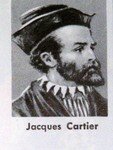
 In 1534, under the reign of François 1st, Jacques Cartier took possession of Canada
In 1534, under the reign of François 1st, Jacques Cartier took possession of Canada
With Samuel Champlain, in 1608 during the reign of Henri IV, the territory became a French colony known as New France. Immediately, a lucrative fur trade began. Indeed, beaver fur and other wild animals were used to make felt which were made for caps that everyone wore in Europe at that time. The natives were hospitable people with the newcomers; they helped them to settle and share with them their knowledge of their country. Thus, the French learned from the Indians the techniques of hunting, trapping and survival in the immense American forests. The first French trappers, who were once called woodland runners or travelers dispersed in the Great Lakes area and came into contact with new tribes.
The fur traders in their turn incited the Indians to trap more animals in order to satisfy an increasing demand. This trade was practiced in the form of bartering. The French introduced instruments and tools made out of metal such as knives, hatchets, needles, various containers, but also glass beads, fabrics and ribbons. Therefore, the French were now in competition with the English who had also settled in this part of the world. There was a need to find newmarkets such as China. The idea came to mind to cross the American continent from east to west in order to reach the Pacific Ocean. Only by waterway was it possible to cross the complex lush forest at that time in America.
Joliet and Marquette Expedition
Thus, in 1673, an exploration mission was launched led by a Jesuit, Father Jacques Marquette and another Frenchmen from Canada, Louis Joliet. The expedition was made up of a group of two canoes leaving from Lake Superior. They descended the Wisconsin River to the Mississippi and followed the large river which they hoped would lead them west into the Pacific. During their voyage they took risks by collecting plant samples and especially coming into contact with the new tribes. The descent of the Mississippi continued without any major difficulty but it was a disappointing voyage. The Mississippi River runs hopelessly towards the south! When they arrived at the confluence of the Arkansas River Marquette and Joliet, learned from the Illinois Indians that the Mississippi continues towards southwest.
The Illinois named the southern region and the western basin of the Mississippi as the country of Wha-Sha-She, a name that Marquette transcribed as Osage. Fearing, that he would enter into Spanish territory and to see his expedition ruined, Marquette decided to return to New France.
Louisiana
Nine years later, in 1682, another Frenchmen, Robert Cavelier de la Salle, completed the Marquette expedition while descending the Mississippi River into the Gulf of Mexico. He really appreciated the discovery of this territory, and dedicated it to the crown of France and gave it the name Louisiana in honor of the Sun King. The Wha-Sha-She (Osage) became, like so many other Indians, subjects to his Majesty Louis XIV, King of France and to the fleet without even knowing it.
The Louisiana territory stretched from the Great Lakes to the Gulf of Mexico and, from east to west of the Mississippi to the Rocky Mountains, therefore making it an immense colony. It was not easy to control with only a handful of soldiers who were woodland runners, who were more attracted by the charm of the Indians, the wilderness, total freedom and the taste of adventure rather than to serve the king.
The Osage
The Osage are of the Sioux family from the south. They are a part of the Deghiha group which is made up of five tribes: Ponca, Omaha, Osage, Kaw (or Kansas), Quapaw (Arkansas). These tribes belong to the same language family. They have the same traditions and were always allies to each other.
During the period of the Louisiana, their hunting territory compared to that of the size of France covering today's existing states; Missouri, Kansas, Oklahoma and Arkansas. They controlled the waterways of the Missouri and Mississippi for trading.
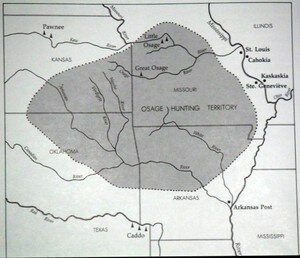
Physically, the Osage warriors were impressive people, with the average height of two meters (6 feet) or more. They were muscular and well built, their chests were traditionally covered with tattoos, wearing collar necklaces made of bone and bear claws, bracelets made of metal around the arm and wrists, rings and various other objects in the ear lobes. They styled their hair by shaving each side of the head and by leaving one strip of hair in the middle, which descended down the neck. For ceremonies or feastdays, they would accentuate their hair style by wearing a roach made of porcupine needles and tinting it with sharp colors, an eagle feather woven at the top and two other feathers which fell along either side of the face.
All body hair was carefully plucked out, including facial hairs and eyebrows. Women were also very beautiful, dressed in buckskin dresses dyed with deep colors, set-off by jewelry made of bone or shells.
The Osage had a diverse economy. The women and children were in charge of agriculture and fruit gathering while hunting was left to the men. Agriculture imposed a sedentary way of life while hunting, especially for buffalo, required a nomadic way of life.
The Osage were thus, semi nomad people, sharing their time between village life in huts at the edge of running waters, and the two annual hunting seasons, in spring and in autumn. The remainder of their time the hunters continued trapping. Fur trade thus, formed a part of their economy and the tribe ambitiously took care of it by maintaining its monopoly in its influential zone. This explains why there were often wars, fights, punitive raids and other types of acts for the goal to steal horses, or capture women for slaves.
The Osage were frightening warriors who knew how to earn respect. The French quickly understood that they could not do without their alliance in this strategically region. They quickly entered their good graces by gift giving and paying respect which would be the only means of maintaining their alleged domination. The trappers flattered the people enormously, especially towards the women, which later many became their wives and they lived in the villages, adopting Osage clothing, habits and customs, integrating themselves into the tribe. They had many children whose descendants still carry today such names as De Noya, Revard, Chouteau, Labadie, Clavier, Robedeaux, Larose, Boulanger.
The Occitans people left many marks of their passage in America: the town of St Louis, founded by Bearnais Baron de Laclede; the town of Detroit, founded by a Tarn-and-Garonnais (an Occitan region) a certain Lamothe-Cadillac (the Cadillac trademark), the Gasconnade river and still more...

Bonaparte and Jefferson
In 1803, Napoleon Bonaparte was just a First French Consul but already considered himself as the head of France. He promised himself an incredible destiny, which would need a great deal of money. What to do with this remote colony of the Americas, so difficult to control and so demanding on the soldiers? Talleyrand advised him, to call upon the President of the United States, Thomas Jefferson. He was formally the ambassador in Paris during the Revolution and who could hardly believe the unexpected proposal made to him. The Louisiana territory was offered to him on a silver platter for the moderate sum of 15 million dollars! He bought it and thus, double the surface of his country with one strike. The Federate Republic of the founded thirteen American colonies now stretched to the Rocky Mountains. The Plains Indians became American without even knowing it. However, their descendants would have to wait until 1929 to obtain citizenship!

The French were no longer masters of this part of the world. The Osage were apart of those who would regret it. As surprising as it may have seemed, a group was formed by the chief: Ki-He-Kah-Shinkah (Little Chief) with a project «to pay a visit to the French within their tribe». This was the beginning of an epic journey!
The voyage
It was now 1827. From that moment on during four years in the village of Kansas at the edge of the Osage River, an affluent of the Missouri River, the Osage stored beaver, fox and bear skins. It was the only currency, which they had to pay for the organized voyage across the "Great Water". The group included a dozen volunteers of men and women determined to do the adventure. They built rafts and loaded them with skins, weapons and luggage and which carried them until the Missouri River. From there, they descended the confluence from the Mississippi until New Orleans and crossed the "Great Stinky Water" to the country of the French. The first part of the voyage went well. Alas, on the lower confluence of the Missouri, just before reaching the Mississippi confluence and the town of Saint Louis, the rafts capsized in the rapids and all the skins were lost.
Discouraged and worried by this ill omen the majority of the Osage decided to return to the village. Six of them decided to continue.
The group was now reduced to but four warriors and two women. Chief Ki-He-Kah-Shinkah(Little Chief) and his wife Gthe-Do'n-Wi'n (Hawk Woman); the warrior Washinka-Sabe(Black Spirit) and his wife Semi-Ho'n-Mi-Ho'n-Ga (Sacred Sun) 19 years old and a relation of Hawk Woman; A-ki-Da-Tonkah (Great-Protector-of-the-Earth) was the spokesman of the village and was called Great-Soldier and finally, the sixth member of the group namedMinckchata-hooh (Young Soldier).
Now here they were in St Louis, which was then just a large village with the two most important confluences in North America. They met a Frenchmen, David Delaunay, wearing a beautiful colonel uniform of the United States army. He already had a hunch that he could make an exhibition of these "savages" in France. It was during the romantisme period: the French author Chateaubriant had just published «Voyage in America» and, in the preceding year, the "Adventures of the Last of Abencerages".
Delaunay proposed to finance their voyage. The Osage accepted. The group descended the Mississippi River by steamboat and arrived at New Orleans where they embark on a sailing ship: The New England en route for Le Havre. It was at the end of June 1827.
The country of the Frenchmen
On July 27, 1827 at midday, under a radiant sun, the New England ship entered Le Havre harbor. The whole city of forty thousand people was already informed of the imminent arrival of the Indians just the day before. The entire population of Le Havre swarmed to the harbor. There were already people standing on their balconies, on rooftops of houses and even right up to the boats where one could see clusters of people clinging onto the ships. A welcoming triumph!
On the New England deck, stood the four half-naked warriors of golden smooth brown skin. Their shaved skull mounted with pricked peak of eagle feathers. Their faces were painted in red and with green stripes; on their arms, they wore silver bracelets and beaded necklaces. They stood stoic and well poised underneath the piercing sun holding a spear in one hand, and some of them even had a club in the other, all of them carried bows and arrows. The women were also dressed traditionally: a blouse with sharp colors; a red rap-over skirt with ribbons applied to it, leggings and moccasins. Their long hair, combed carefully, and worn freely down their back. They had a colored down-hairpiece hanging down the side of their faces.
The extremely cramped crowd, escorted them off the sailing ship and led them into a horse carriage, which brought them to Holland Hotel. Their first visit was with the city mayor who greeted them according to French custom, that anyone who gives an official speech was offered a glass of champagne. Muscat of Rivesaltes were shot that day showing the splendors at «Big Soldier » they probably had a little too much to drink.
The following days there after were a swirl of entertainment: a ride in a carriage, parade of troops to the citadel, riding the Ferris wheel, sparing, physical sports, banquets, invitations, etc. Women had the pleasure of offering the young Indian ladies costume jewelry and toiletry requisites, which were accepted with joy. But the Indians couldn't stay there forever. Paris was waiting for them!
In the morning of August 7, strangely dressed in blue frock coats, the Indians embarked on a steamboat the «Duchess of Angouleme» which went up the Seine River. The first stop-over was in Rouen where, once again, forty thousand gawking people were gathered for hours. The August 12th issue of the «Monitor» Journal began to spread the news: «Six Indians create a fury in Rouen.» The crowd besieged the town hall. On August 8th they went to the theater in an open carriage and by custom, sat in the Governor's booth... After the first act the prince rose and spoke in his language a lot of extremely pleasant things undoubtedly the Indians could not understand... The crowd was so curious that during the intermission, they raised the curtain so that the public could have a better look at the Indians. Rouen enjoyed only five days of their presence. On August 13, the Osage went up in the «Vélocifère» a stagecoach heading for Paris.
Paris
Their first outing was their visit with the Baron de Damas, the Foreign Minister, who had invited them for a meal among 40 guests. Two days later, on August 21, they went to the Saint-Cloud Royal Court where they were introduced to Charles X and to the Princes. These official duties were fulfilled. The Indians were the prey of the Parisian public eye... and of the crafty Delaunay. (The ladder had put an ad in the newspapers to finance each outing in order to come and see the Indians. Moreover, the theater directors argued over who would have the privilege of hosting the Osage whose presence, had already been announced beforehand, and that the theater would be completely full whatever the show. Thus they were dragged to the Opera houses of Gaite, Nouveautes, Varietes, l'Odeon, etc. The newspaper "Le Figaro" maliciously printed «the theater directors has just made a debut of six savages for the prosperity of their administration »... )
In Tivoli, the Osage were the stars of "extraordinary festivals". Their presence were known at the water show at Bercy; the wax museum where they could see their doubles; on a steam boat from Paris to Saint-Cloud; with the military march at Vincennes; and at the King's Garden zoo where they were baffled by the incredible giraffe. A slight madness settled among the Parisians. In cafes, they were serving the "Osage punch", the fashion industry launched "the Osage design" or "the Missourian wool". Fashion was Osage... At the end of October the press stopped writing about the Osage. Shortly there after, Delaunay, who was recognized as a swindler by one of his former victims put him in prison. The Osage who were brought over by Delaunay did not know how they would return to their country. They set off on the roads of France.

In spring of 1828, they were in Belgium. In Liege, the young Sacred Sun had twins which one of them was adopted by a Liegeois. In January 1, 1829, they were found abandoned and dying of hunger at Friboug-in-Brisgau; they wandered through Germany, the Netherlands, Switzerland and down to Italy. Finally they separated into two groups, no doubt because of a disagreement on how they would return to their country. One group wanted to find help from Lafayette so they returned to Paris. While the other group counted on Mgr. Louis-Guillaume Dubourg, a former bishop of Louisiana, stationed in St. Louis where he sent the evangelical missionaries to the Plains Indians. The Osage knew him well and many were baptized by him in their tribe. They learned that Mgr. Dubourg had been ordained to the seat at the diocese of Montauban, in southwest of France.
Montauban

Little Chief, Hawk Woman and Big Soldier traveled to south of France. They stopped in Avignon where the Deputy Mayor, Hector de Laurens, made a vote to subsidies their trip and come to their assistance. Winter was early that year. It was in November 1829: the small famished and exhausted group crossed the Old Bridge (Pont Vieux) of Montauban. The Tarn River had been frozen for several days. At the end of the bridge, they turned right and went up Bath Street. Still a few meters to go and they found themselves in front of the gates of Aliès Hall, the Bishop's residence (today known as the Town Hall of Montauban). Louis-Guillaume Dubourg accommodated them in his residence and comforted them. The following day he organized a collection in the diocese, among the nobles and the bourgeois, and the Mayor of Toulouse who was also asked for support. The Montalbanais were generous people: in a few days they reached the sum to finance their voyage back home and would be the end of a nightmare. The Osage embarked on a boat, which descended the Tarn River then, the Garonne River until Bordeaux. Finally "Bayard" brought them back to their country.
And the Other Three?
They had a failed attempt in Paris of September 1829 when the Consul General of the United States, Mr. Barnet, helped by Lafayette lodged them and fed them until they were strong enough to take them to Le Havre Harbor. Just at the moment of their departure all their finances for their trip were seized by the creditors by the debt of their dishonest personal manager Delaunay. The two men caught chicken pocks during their trip back and Sacred Sun returned home alone to her native land with her baby. Upon their return to their
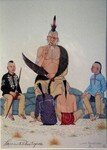 village the Osage told their adventures of mishaps. Their two and half years stay had left a deep mark in their spirit, as their story did not die. In fact, the story lives thanks to them and to the oral tradition, which was passed on from generation to generation with such great loyalty. In fact, the story had been written for the first time in the 1929 issue of the Missouri Historical Journal. It was later translated and printed in the French magazine the «Historama» (issue number 40 of June 1987) in an article entitled «Red Skins in Paris» written by Guillaume de Berthier de Sauvigny to which a great part of these accounts were taken.
village the Osage told their adventures of mishaps. Their two and half years stay had left a deep mark in their spirit, as their story did not die. In fact, the story lives thanks to them and to the oral tradition, which was passed on from generation to generation with such great loyalty. In fact, the story had been written for the first time in the 1929 issue of the Missouri Historical Journal. It was later translated and printed in the French magazine the «Historama» (issue number 40 of June 1987) in an article entitled «Red Skins in Paris» written by Guillaume de Berthier de Sauvigny to which a great part of these accounts were taken.
But the Story Doesn't End Here!
The Indians were a bother to the expansion projects to the west by the Whites. The Osage were moved to a reservation with another tribe of Missouri to Kansas and then finally to Oklahoma. A reservation was allotted to them in north of what was then called "Indian Territory" which is today known as Oklahoma. The territory is the size of the surface of two French departments, but insufficient enough for hunting. Besides the buffalo would soon disappear and... their heart was no longer there. The tribe withered away, and went dormant. Until oil would awake them.
The Oil
The black gold soaked the basin of the reservation like a sponge. They already knew the existence of oil but before the beginning of the 20th century, who would have thought at that time that this black and nauseous oil would make an engine run?
The Automobile boom would change everything. The states of Oklahoma, Texas, and part of Kansas were covered with derricks. On the Osage, reservation, oil wells were among the richest. The Osage lived the greatest economic miracle in their history. Oil companies came to exploit the layer and pay large royalties to the tribe. Officially the tribal count which was given by the Bureau of Indian Affairs was 2229 Osage in 1909. They were allotted shares, each Osage living at that time of distribution; adult or child, including a new born were accredited with shares. It was a time of wealth. Careless tribal members launched into a sumptuous life style, building mansions, buying the most luxurious cars, dressing their wives with fine jewelry. The American newspapers constantly raved about their lavious life style. This caught the attention of adventurers, con artists and swindlers who exploited the Osage's unusual naivete on handling the dollar. The most sinister of these gangsters would go as far as violence such as murders, criminal explosions, voluntary fires which would discourage the victims and to leave the territory where the majority moved towards southern California where they would remain bonded within themselves and to their families back in Oklahoma.
Other Osage families were more careful and sent their children to the best schools. They would return with a higher education and fill high positions within American companies.
The Osage tribe still exists and there are about sixteen thousands of members of which half approximately still live on the reservation, known today as the Osage County. Its Tribal Council meets regularly in Pawhuska, capital and also headquarters of the Osage county. The Osage people hold various occupations or are unemployed and, whatever their social condition today, are living according to American standards.
But they all come together during their, modern or traditional ceremonies, to maintain their traditions, their identity and their culture. The present day Osage are now cultural warriors.

In June 1987, Jean-Claude Drouilhet founded the association after having read an article in «Historama» journal. It was there were he discovered with great surprise the story relating to the three Osages who were in the town of Montauban 1829. He launched a project to invite the Osage to Montauban. He wrote to the tribe. The Principal Chief, George Tallchief, and Mrs. Angela Robinson (an Osage Lady) accepted the project and the cultural exchanges.
This was just the beginning of a new adventure!


/https%3A%2F%2Fstorage.canalblog.com%2F75%2F15%2F247410%2F47221451_o.jpg)
/https%3A%2F%2Fstorage.canalblog.com%2F96%2F23%2F247410%2F15592862_o.jpg)
/https%3A%2F%2Fstorage.canalblog.com%2F16%2F00%2F247410%2F15411764_o.jpg)
/https%3A%2F%2Fstorage.canalblog.com%2F59%2F13%2F247410%2F12186166_o.jpg)
/https%3A%2F%2Fstorage.canalblog.com%2F19%2F47%2F247410%2F11725085_o.jpg)



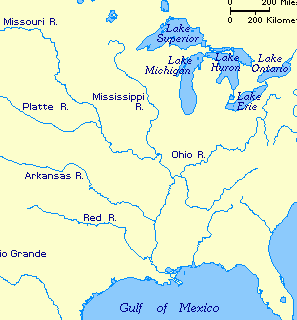












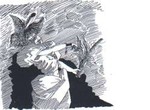




/https%3A%2F%2Fstorage.canalblog.com%2F54%2F27%2F247410%2F131774634_o.png)
/https%3A%2F%2Fstorage.canalblog.com%2F09%2F97%2F247410%2F130967495_o.jpg)
/https%3A%2F%2Fstorage.canalblog.com%2F94%2F33%2F247410%2F130960903_o.jpg)
/https%3A%2F%2Fstorage.canalblog.com%2F75%2F65%2F247410%2F130946739_o.jpg)